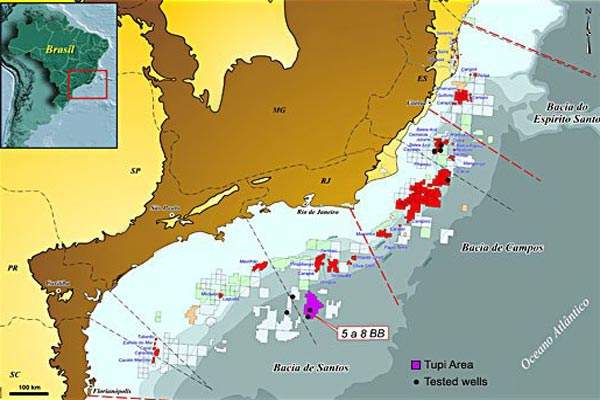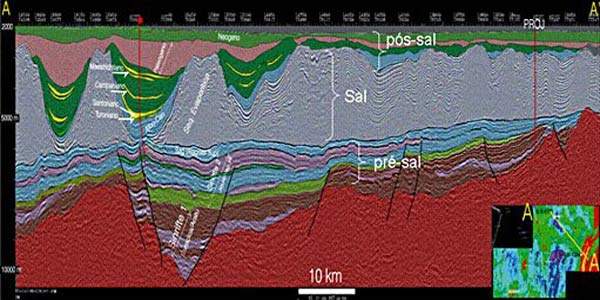In late 2007 Petrobras discovered a new offshore province crossing the Espírito Santo, Campos and Santos basins. This oil province lies under unusually large layers of salt, up to 2,000m in thickness. Tupi is the largest of these accumulations.
The field is operated by Petrobras, which holds a 65% interest. BG Group and Galp Energia hold 25% and 10%, respectively.
Tupi geology and discovery
The Tupi reservoir lies in a pre-salt layer. The crude oil is an intermediate corresponding to specific gravity of approximately 0.88. It has low sulphur content and is considered to be sweet.
The Tupi field was discovered in October 2006 by BG Group. It is the largest such discovery ever made in the region and is expected to transform Brazil into a global oil giant.
Tupi reserves
The volume that was discovered in the Tupi accumulation alone may be enough to boost the current Brazilian oil and gas reserves by more than 50%. The reserves currently stand at 14 billion barrels.
The area is estimated to have five to eight billion barrels of recoverable light oil and natural gas in the pre-salt reservoirs.
In October 2010 Petrobras found additional light oil in the pre-salt reservoirs.
Tupi field development
The Tupi field is being developed as a pilot project in two phases. In the first phase tests will be conducted to gather information about the future production systems. This phase is expected to end in 2012.
The second phase is expected to start from 2012 and will include two parts. In the first part (2012-17) ten production units will be installed at the field with 20 producing wells and injectors expected to be drilled during this time.
In the second part of phase two (after 2017), new technologies such as dry completion units will be employed to recover oil and natural gas from the field.
At a cost of around $1bn, 15 wells were drilled in the mid-2000s that reached the pre-salt layers. Eight wells were tested and evaluated. These wells produced high commercial value light oil and a large amount of associated natural gas. In April 2009 the first crude oil from the test well was extracted.
Petrobras’ goal is to start producing in Tupi by end of 2010, with an estimated production rate of 100,000bpd in 2011-12. Stockbrokers Wood MacKenzie estimated that the total field will cost between $50bn and $100bn to produce.
In order to reach the hydrocarbons, which lie at depths around 4,000m to 5,000m below the ocean floor, Petrobras had to develop new drilling projects, making it the only operator company, with or without partners, to drill, test and evaluate pre-salt rocks. New production technologies will be necessary for the development of the Tupi field. Salt at this depth is reported to act like sludge, with some unknown physical properties. This means that construction of an effective well-bore may be difficult.
Tupi production
In the first phase, five to six production wells, two water injectors and a gas and a carbon dioxide injector well will be drilled. The gas produced at the field will be transported to the Mexilhao platform from where it will be sent to Monteiro Lobato Gas Treatment Unit in Caraguatatuba, Sao Paulo. Full production of Tupi is expected to require approximately 100 wells.
Cidade de Sao Vicente FPSO
BW Offshore was awarded the contract to convert the BW Peace FPSO into the Cidade de Sao Vicente FPSO in 2008 for the Tupi field. The FPSO was installed at a depth of 2,170m and has a capacity to produce 15,000bpd.
Cidade de Angra dos Reis MV22 FPSO
MODEC was awarded a contract to convert the M / V Sunrise IV oil tanker into the Cidade de Angra dos Reis MV22 FPSO in 2008. The contract is for a 15-year lease.
The FPSO is capable of processing 100,000bpd oil and has a storage capacity of 1.6 million barrels. It is planned to be installed in late 2010 at a water depth of 2,150m.
SBM FPSO
Petrobras signed a contract with SBM Offshore and Queiroz Galvao Oleo e Gas in 2010 for the construction of an FPSO. The FPSO will be installed at a depth of 2,130m of water and will have a production capacity of 120,000bpd of light crude oil.
The natural gas capacity of the SBM FPSO will be 5,000,000m³ per day.
Tupi contractors
Transocean is the drilling contractor for the Tupi field. The oil services and equipment will be provided by Schlumberger. Halliburton supplied seismic interpretation software for the field. Technip will supply infield lines, including 90km of risers and flowlines for the pilot project.









